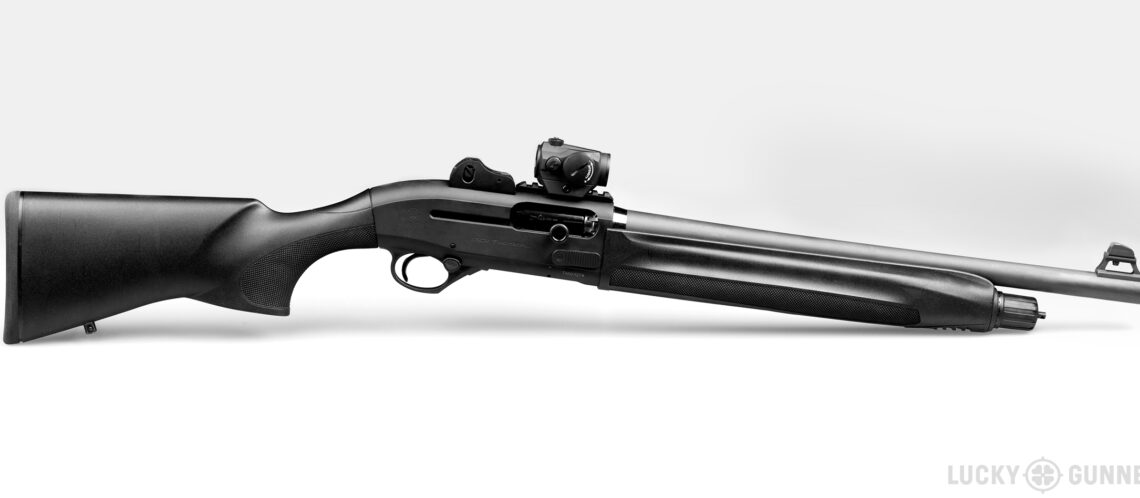Last week, in the first installment of this two-part review, I talked about why I think the Beretta 1301 Tactical is one of the best home defense shotguns on the market. It’s lightweight, it’s got soft recoil, and it comes right out of the box with a lot of great features like the ghost ring sights and optic rail, an oversized bolt handle, and a large safety button that’s reversible for left-handed use.
But there are a few things you should probably know about the 1301 before you go out and buy one. First is the lack of aftermarket support. For instance, you’re pretty much stuck with the length of pull that you get on the original factory stock. You can make it longer by adding the spacers they include with the gun, but the shortest it gets is 13 inches. The ideal length of pull on a defensive shotgun for most people is usually between 12 and 13 inches, but right now, the original factory stock is the shortest one available.
A much bigger problem is that there’s no easy way to attach a light to this shotgun. With an aftermarket extended magazine tube on the 1301, it’s possible to add a barrel clamp near the muzzle that will accommodate a small accessory rail. However, a light mounted that far forward will be too far away to activate with the support hand, so a tape switch would be necessary to operate the light while maintaining a correct grip on the gun. A tape switch isn’t a bad solution in itself, but they typically carry a much higher price tag than standard flashlight mounts, and that’s before you factor in the requisite magazine extension and barrel clamp. Ideally, you would be able to attach a light somewhere on the forend closer to where most people normally grip the gun. But until an accessory like that becomes available, we’re stuck with some less than ideal options for using the Beretta in low light.
The Infamous “Shell Dump”
The last issue with the 1301 is difficult to explain without a visual demonstration. The short video below describes the problem in detail, but I’ll also provide the transcript in case you can’t watch the video right now. Fair warning though, it might not make a lot of sense without watching the demo.
Transcript:
The final issue with the 1301 is really the big one, and it’s a deal breaker for a lot of people. It has to do with this bolt release button. This little guy has a few different functions. The main function is to release the bolt when you’re loading the gun from empty. According to the owner’s manual, the correct procedure for loading the 1301 is to press the carrier stop button which will allow you to lock the bolt to the rear. Then you take your first round and put it directly into the ejection port and hit the bolt release button to close the bolt. That will load your first shell. And then you can load the magazine tube. No problems so far.
Now, if you want to unload the gun without firing it, you pull the bolt handle back to empty the chamber, flip the gun over and then push the little carrier out of the way, and if you hit the bolt release, it will pop a shell right out of the magazine tube. It’s a really convenient way to unload the gun without having to cycle each round through the chamber.
The problem is, if I hit this button when I’m not loading or unloading the gun, if there are shells in the magazine tube, it thinks I’m trying to unload it. But without the carrier moved out of the way, it just spits the shells out onto the carrier. So now I’ve got two shells on the carrier when there’s only supposed to be one. So I can still fire the round that’s in the chamber, but it doesn’t load the next round. The bolt is locked back and I can’t move the bolt handle, the bolt release button doesn’t do anything — it’s not easy to get the gun back into action.
If I want to clear this malfunction, I have to press the carrier stop, and reach inside the ejection port with my thumb. And then push this shell down that’s closest to me, and then this other shells that’s trying to come out of the magazine tube, I have to push it back in until it clicks. And now as soon as I move my thumb out of the way, the bolt is going to close. Now I’ve got a round chambered and I can start firing again.
If I manage to induce this malfunction at the range, it’s just an annoyance. If it were to happen when I’m responding to a home invasion, it could be a disaster. It’s really disappointing that Beretta designed it this way, especially for a shotgun that otherwise seems so well thought out.
I do know of an aftermarket modified bolt release that’s in the works that will fix this problem. But I don’t know when it’s coming out, and until there’s a hardware fix available, if you want to use a 1301 for home defense, you’re just going to have to pay extra attention to what condition you have that gun stored in and how to get it loaded without jamming it up. (UPDATE: Two aftermarket products are now available that completely eliminate the “shell dump” issue! Details in this post.)
Storing the 1301 for Home Defense
A lot of people are going to want to store the gun in some kind of cruiser ready type condition — that’s with the magazine full and the chamber empty. If you set the gun up this way, however, you can’t just grab it out of the closet and rack the bolt to chamber a round. If there’s no shell already on the carrier, running the bolt doesn’t accomplish anything. So for a home defense gun, it’s wise to “pre-load” a round onto the carrier before storing it. That is accomplished by pressing the carrier stop button (the small button located at the base of the shell carrier/lifter) which will eject one shell from the magazine tube onto the carrier. So instead of trying to remember which button to press under stress if you have to grab the gun in an emergency (and to avoid possibly pressing the bolt release instead of the carrier stop button), simply store the gun with a round already on the carrier. That way, you can just pick it up, rack the bolt, and the gun is loaded and ready to go.
Obviously, whether you keep the gun in some kind of cruiser ready condition or if you keep it fully loaded, if you ever leave the house, or if you have small kids around, lock the gun up to prevent it from being mishandled or stolen.
Final Thoughts
I titled this review “the People’s Shotgun” because I really wanted to be able to recommend the 1301 to anybody looking for a home defense gun. It’s so easy and enjoyable to shoot, it’s at least as affordable as an entry level AR-15, and it’s great for someone who might have trouble running a pump action.
But like most semi-automatic shotguns, the Beretta 1301 Tactical can be complicated to operate without some training and dedicated practice. If that doesn’t intimidate you, and you’re willing to put in the effort to learn the quirks of the 1301, it might be worth it because otherwise, it’s really is a fantastic shotgun. But let’s be honest; there are no perfect shotguns. They all have some kind of weird quirks — whether it’s ammo sensitivity or awkward controls or the potential to short stroke a pump action — there’s not an option that doesn’t have at least some learning curve. So really, picking out a home defense shotgun becomes a matter figuring out which shortcomings you’re willing to deal with. I think the Beretta 1301 is worth the extra hassle, but as much as I hate to admit it, it’s definitely not for everybody.




